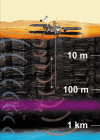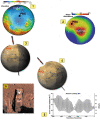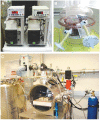Mars Extant Life: What's Next? Conference Report
- PMID: 32466662
- PMCID: PMC7307687
- DOI: 10.1089/ast.2020.2237
Mars Extant Life: What's Next? Conference Report
Abstract
On November 5-8, 2019, the "Mars Extant Life: What's Next?" conference was convened in Carlsbad, New Mexico. The conference gathered a community of actively publishing experts in disciplines related to habitability and astrobiology. Primary conclusions are as follows: A significant subset of conference attendees concluded that there is a realistic possibility that Mars hosts indigenous microbial life. A powerful theme that permeated the conference is that the key to the search for martian extant life lies in identifying and exploring refugia ("oases"), where conditions are either permanently or episodically significantly more hospitable than average. Based on our existing knowledge of Mars, conference participants highlighted four potential martian refugium (not listed in priority order): Caves, Deep Subsurface, Ices, and Salts. The conference group did not attempt to reach a consensus prioritization of these candidate environments, but instead felt that a defensible prioritization would require a future competitive process. Within the context of these candidate environments, we identified a variety of geological search strategies that could narrow the search space. Additionally, we summarized a number of measurement techniques that could be used to detect evidence of extant life (if present). Again, it was not within the scope of the conference to prioritize these measurement techniques-that is best left for the competitive process. We specifically note that the number and sensitivity of detection methods that could be implemented if samples were returned to Earth greatly exceed the methodologies that could be used at Mars. Finally, important lessons to guide extant life search processes can be derived both from experiments carried out in terrestrial laboratories and analog field sites and from theoretical modeling.
Keywords: Astrobiology; Biosignatures; Life detection; Life in extreme environments; Mars extant life.
Figures











References
-
- Allen C.C. and Oehler D.Z. (2019) Searching for martian bio-indicators and extant life using spacecraft [abstract 5011]. In Mars Extant Life: What's Next? Conference Abstracts, Lunar and Planetary Institute, Houston. Available online at https://www.hou.usra.edu/meetings/lifeonmars2019/pdf/5011.pdf
-
- Allwood A., Clark B., Flannery D., Hurowitz J., Wade L., Elam T., Foote M., and Knowles E. (2015) Texture-specific elemental analysis of rocks and soils with PIXL: the Planetary Instrument for X-ray Lithochemistry on Mars 2020. In 2015 IEEE Aerospace Conference, IEEE, Piscataway, NJ, doi: 10.1109/AERO.2015.7119099 - DOI
-
- Bakermans C. and Whyte L.G. (2019) Terrestrial permafrost as a model for microbial growth at low temperatures: implications for extant life [abstract 5040]. In Mars Extant Life: What's Next? Conference Abstracts, Lunar and Planetary Institute, Houston. Available online at https://www.hou.usra.edu/meetings/lifeonmars2019/pdf/5040.pdf
-
- Bar-Cohen Y., Sherrit S., Badescu M., Lee H.J., Bao X., and Chang Z. (2018) Drilling mechanisms using piezoelectric actuators developed at Jet Propulsion Laboratory. In Outer Solar System: Prospective Energy and Material Resources, Springer International Publishing, Cham, Switzerland, pp 181–259
-
- Beaty D.W., Buxbaum K.L., Meyer M.A., Barlow N., Boynton W., Clark B., Deming J., Doran P.T., Edgett K., Hancock S., Head J., Hecht M., Hipkin V., Kieft T., Mancinelli R., McDonald E., McKay C., Mellon M., Newsom H., Ori G., Paige D., Schuerger A.C., Sogin M., Spry J.A., Steele A., Tanaka K., and Voytek M. (2006) Findings of the Mars Special Regions Science Analysis Group. Astrobiology 6:677–732 - PubMed
Publication types
MeSH terms
Substances
LinkOut - more resources
Full Text Sources
Miscellaneous
